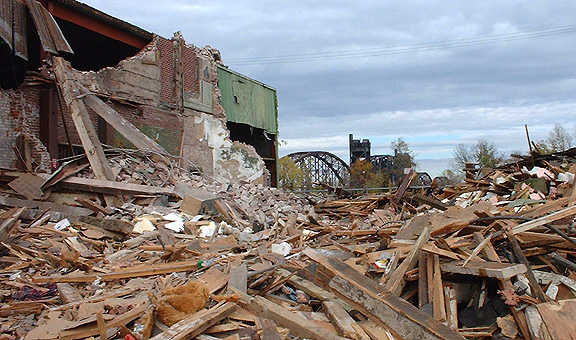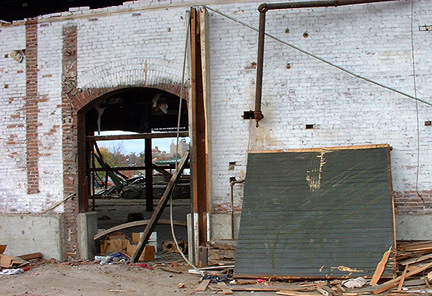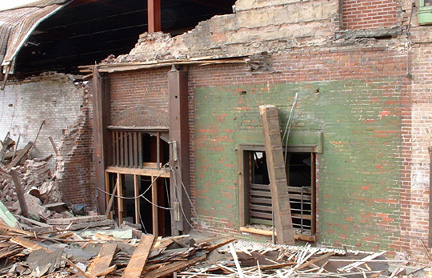 |

|
and the Choctaw Terminal
The Central Arkansas Library System with support from the Friends of the Central Arkansas Library System recently (2001) completed a renovation of the Cox building, a triangular shaped three-story brick warehouse which had originally been constructed about 1902. This building, a contemporary of the Choctaw freight station, is smaller and was constructed in a simpler style, without the ornate brick archwork which characterized the freight station. Since restoration, the Cox building has become one of the focal points of the River Market District, and its popularity continues to grow as groups discover the classic third floor meeting area with a dramatic view of the River Market and the Arkansas River. The adaptive reuse of this old structure provides an example of what can be accomplished with older buildings, preserving the essence of the building while adapting them to present day uses never imagined by their original builders.

Compared to the exemplary restoration of the Cox Building, the short-sighted actions of the Clinton Library Foundation stand in stark contrast. After viewing (or actually visiting) the Cox Building, imagine the adaptive reuse opportunities which would have been possible with the nearby Choctaw freight station, had a more enlightened and imaginative approach prevailed. It is indeed unfortunate that an important part of our heritage was erased in hours, as a result of decisions by those who had a personal agenda that in this instance was in conflict with the public interest. 
Above: Remaining tapered brickwork from arched front window. 
In fairness to the Clinton Library Foundation, it must be noted that the foundation has agreed to utilize (rather than demolish) the 1899 Choctaw, Oklahoma & Gulf passenger station, and they have also agreed to renovate the 1899 CO&G bridge across the Arkansas River for use as a pedestrian/bicycle pathway. The library foundation is currently estimating costs of $2.8 million for the passenger station and $4.0 million for the bridge. Preservationists and others interested in history applaud the decision to keep two-thirds of the Choctaw terminal complex. The cost estimates for these two items should be viewed in the context of the entire project, which is estimated to approach $200 million, meaning that approximately 3.5% of the total project cost will be related to preservation and remodeling of historic structures which the foundation deemed useful to their project. Much of the expenditure for the passenger station and bridge is not for historic preservation or restoration, as such, but rather to readapt the structures for the library's usage. Had the passenger station not received a massive interior and exterior renovation by the Spaghetti Warehouse restaurant chain some years ago, it would almost certainly have faced the same fate as the Choctaw freight station.
In the case of the bridge across the Arkansas River, it has been determined that a pedestrian/bicycle walkway between the presidential library and the Alltel Arena (a sports/entertainment center) would benefit both the arena and the library. Much of the expenditure for the bridge will be necessary to install ramps and elevators to allow pedestrians to access the elevated lift span, and to make the walkway ADA compliant. It remains to be seen how severely these modifications will affect the historical appearance of the bridge.
The controversy over the Choctaw freight station is not about the failure of the library foundation to support some preservation efforts. The controversy arose because the freight station was in remarkably well preserved condition, it was a critical historic component of the CO&G Railroad's presence in Arkansas, and it should have been incorporated into the library project from the beginning. The timing on the awareness of the freight station was unfortunate - preservationists should have been more aware of the structure, and library site engineers who scouted the entire site in advance were unquestionably aware since they were the first Clinton Library Foundation agents to actually see the hidden parts of the Choctaw freight station.
A particularly onerous aspect of this fiasco was the failure of the Clinton Library Foundation, and thus the City of Little Rock, to give any serious consideration to alternatives to demolition. When knowledge of the freight station became public, and when public support began developing for the building's preservation, the immediate response from library leaders was that it was too late in the process to change the blueprints. Considering the inevitable changes that take place as a project moves from blueprints to actual construction, it strained credibility for library leaders (followed by city officials) to argue that it was "too late" when the change could have been little more than the realignment of a minor component of the library. Obviously some change could be an expense, but no realistic determination of the cost of this minor modification was ever provided, other that a ridiculous, wholly unsubstantiated estimate of "...millions of dollars."

Above: Looking west through the arched opening which once held sliding door number 2, The vertical wooden slotted assemblies adjacent to the arched freight doors were part of the track mechanism for the door counterweights, connected to the doors themselves by a cable and pulley arrangement. 
National Historic Preservation Act - Section 106: The demolition of the historic Choctaw freight station may have far reaching reprecussions for preservationists across the nation. When this controversy began, efforts were made to require the City of Little Rock to comply with Section 106 of the National Historic Preservation Act (NHPA)of 1966. Section 106 mandates a comprehensive historical and archeological assessment, along with required public input from interested parties, if federal funding used for the project would adversely affect any historical site or building. There is no argument that the demolition was an "adverse effect," and the ultimate user for whom the site is being cleared -- the Clinton Presidenial Library -- will interact with and receive assistance from numerous federal agencies. The intent of Section 106 was to protect historic properties that might be adversely affected by a very broad range of federal activities. The City of Little Rock's legal counsel apparently advised that the city was not obligated to perform a Section 106 review because the city is not using federal funds to clear the site. With this somewhat unorthodox "arms-length" arrangement, the City of Little Rock performed work that the library itself would have been prohibited from performing, namely the demolition of a historic property. A simple removal of the metal warehouse annex which coccooned the the Choctaw freight station would only have immediately made the property eligible for listing on the National Register of Historic Places. As an illustration of the relative simplicity of uncovering the building, removal of the metal siding was accomplished in a matter of hours before the actual demolition of the station took place.
Little Rock's failure to comply with NHPA Section 106 has established a dangerous precedent which effectively circumvents the intent of Section 106. It had been hoped that a judge might interpret the law in a different manner than the City of Little Rock's legal advisors, finding the city guilty of anticipatory demolition - razing the structure with the intent of evading the provisions of Section 106. In a worst case scenario, a ruling of this nature would prohibit any federal funding for the library, placing the archives and perhaps the library itself in jeopardy. Unfortunately, a subsequent judicial ruling placed the City of Little Rock activities outside the scope of Section 106, thus encouraging developers of other sites in the future to choose the "Little Rock strategy" of removing historic structures before the site comes under the protection of Section 106. Loss of the freight station is an unsavory legacy; the City of Little Rock/Clinton Library Foundation's collusion which opened a large loophole in existing historic preservation laws is even worse.
Above: Quoins on right side of main entrance, The former main entrance to the building is choked with debris from the collapse of the upper floor.
|